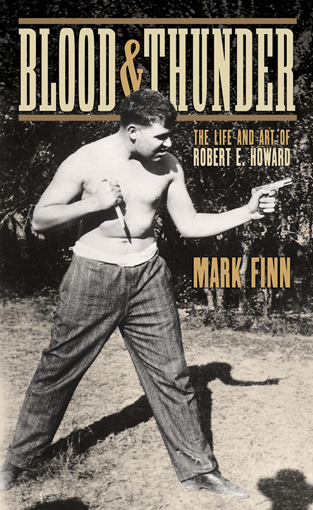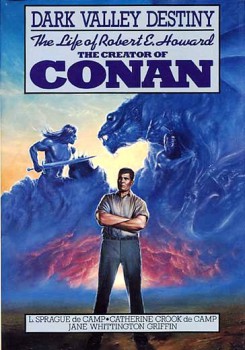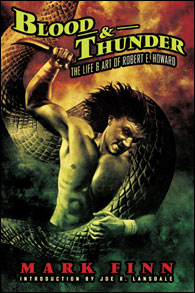Updated Blood and Thunder Portends Good Start to 2012 for Robert E. Howard Fans
 2011 hasn’t been the kindest year for fans of Robert E. Howard. January saw the end of the fine Del Rey series of Howard originals with the publication of the 11th and final volume Sword Woman and Other Historical Adventures (sigh). In August we got a crummy new film purporting to be REH’s Conan that resembles no story the Texan ever wrote, and is currently sporting a woeful 22% “rotten” rating over at Rotten Tomatoes (still think you can tell a better story than REH, Marcus Nispel?)
2011 hasn’t been the kindest year for fans of Robert E. Howard. January saw the end of the fine Del Rey series of Howard originals with the publication of the 11th and final volume Sword Woman and Other Historical Adventures (sigh). In August we got a crummy new film purporting to be REH’s Conan that resembles no story the Texan ever wrote, and is currently sporting a woeful 22% “rotten” rating over at Rotten Tomatoes (still think you can tell a better story than REH, Marcus Nispel?)
But the waning days of 2011 have brought a bit of good cheer to brighten the day of Howard fans everywhere: News of the publication of a new and improved second edition of the REH biography Blood and Thunder: The Life and Art of Robert E. Howard by Mark Finn.
Monkeybrain books published the first edition of the Blood and Thunder in 2006 in paperback; the second edition is being published in a limited run of 150 hardcover copies by the Robert E. Howard Foundation at a cost of $50 ($45 for members of the foundation). You can pre-order it now and it’s expected to ship by the end of January 2012. Here’s a description from the REH Foundation webpage:
Alongside the success of “Conan the Barbarian” was a neatly packaged, sound byte biography of a tortured young man, full of volcanic rages, playing at war inside his head, while the citizens in the small town of Cross Plains laughed at him behind his back—a man so undone by his circumstances and so strangely devoted to his mother that, on her deathbed, he pre-empted seeing her die by committing suicide.
In Blood and Thunder: The Life and Art of Robert E. Howard, author Mark Finn dispels many of those old, outdated myths that have grown up around Howard and his fictional creations. Armed with twenty-five years of research and a wealth of historical documents, Finn paints a very different picture from the one that millions of fans of Conan have been sold throughout the years.
Finn has apparently made some substantial additions to the text from first edition to second, padding it out to a hefty 454 pages. According to a recent Q&A conducted with Finn on the fine website REH: Two-Gun Raconteur, the second edition contains “35,000 additional words, a new index, notes on the chapters, new material in the Conan and Breck Elkins chapters … new facts and pieces of info about a number of things, and all chapters save the first two have something new and different in them.”
Finn is not only including more material but also some new interpretations of REH’s life and art, including the claim that REH wrote Conan mostly for commercial considerations:
I make the charge that Conan was written for specific commercial considerations in Weird Tales. That’s not to say he phoned them in, but he was pitching specifically to Wright. And that’s why there’s things in the Conan stories that don’t jibe with the rest of Howard’s work–things like his mercurial attitudes about damsels in distress. I contend that the scholars and fans have been looking at it the wrong way: Conan is the anomaly. If you take those stories out of the picture, suddenly Howard becomes a proto-feminist. Put them back in, and he’s just another pulp author indulging in macho sex fantasies. That’s just an example, but I think you get what I’m saying.
 Until Finn wrote Blood and Thunder the only full length biography of Howard on the market (now out of print, though still widely available second-hand) was L. Sprague de Camp’s Dark Valley Destiny. Finn wrote Blood and Thunder not only to get an REH bio back into circulation but also to set the record straight on some of the myths and misconceptions spread by the DeCamp-ian version of Howard’s life.
Until Finn wrote Blood and Thunder the only full length biography of Howard on the market (now out of print, though still widely available second-hand) was L. Sprague de Camp’s Dark Valley Destiny. Finn wrote Blood and Thunder not only to get an REH bio back into circulation but also to set the record straight on some of the myths and misconceptions spread by the DeCamp-ian version of Howard’s life.
Dark Valley Destiny is, to put it mildly, a heavily flawed work. DeCamp was quite complementary of Howard’s writing (“Howard was a poet, and in time he learned to write poetry in the form of prose. In many of his prose passages, there is a trace of the rhythm of Shakespeare and of the seventeenth-century King James Version of the Bible”) and also expressed a fair degree of sympathy with Howard’s plight as a struggling writer facing doubts about his self-worth and talent. It also contains valuable interviews and first-hand accounts from many of the Cross Plains residents who knew Howard in the 1920s and 30s.
But Dark Valley Destiny also contains merciless attacks on Howard’s character, sprinkled with a heaping helping of patronizing. It’s littered with poor, uncorroborated, half-baked psychoanalysis and wild speculation. Some of de Camp’s formulations and opinions come across as simply mean-spirited and small. I’m still convinced Dark Valley Destiny can still be read, but with a good degree of caution and caveats. I would not recommend it for readers new to REH who are seeking to learn more about the man behind such great characters as Kull of Atlantis and Solomon Kane.
 Thankfully we now have Blood and Thunder as a long-overdue counterpoint and corrective. Blood and Thunder is a mine of information on Howard’s early life, his relationship with Novalyne Price, and his correspondence with H.P. Lovecraft. Finn acknowledges the huge influence of Conan but spends equal or more time on some of some Howard’s lesser-known creations, including the boxer Sailor Steve Costigan, Francis X. Gordon (aka. “El Borak”) and Breckinridge Elkins. Blood and Thunder’s most convincing claim is that Howard was very much a product of his environment. Howard was born and raised in early 20th century Texas, one of the last vestiges of American frontier life. Howard’s father, a physician, moved his family from small town to small town, following work that spilled over from the boom-and-bust cycles of oil speculation. These small towns were wild and violent places, Finn writes, and Howard the elder’s services were needed to stitch men back together. Into this potent mix of brawling, wealth-chasing men, towns that knew untapped wealth and crushing poverty in a span of days, and the wide open plains of sand and scrub of rural Texas, Howard’s career as a writer was born.
Thankfully we now have Blood and Thunder as a long-overdue counterpoint and corrective. Blood and Thunder is a mine of information on Howard’s early life, his relationship with Novalyne Price, and his correspondence with H.P. Lovecraft. Finn acknowledges the huge influence of Conan but spends equal or more time on some of some Howard’s lesser-known creations, including the boxer Sailor Steve Costigan, Francis X. Gordon (aka. “El Borak”) and Breckinridge Elkins. Blood and Thunder’s most convincing claim is that Howard was very much a product of his environment. Howard was born and raised in early 20th century Texas, one of the last vestiges of American frontier life. Howard’s father, a physician, moved his family from small town to small town, following work that spilled over from the boom-and-bust cycles of oil speculation. These small towns were wild and violent places, Finn writes, and Howard the elder’s services were needed to stitch men back together. Into this potent mix of brawling, wealth-chasing men, towns that knew untapped wealth and crushing poverty in a span of days, and the wide open plains of sand and scrub of rural Texas, Howard’s career as a writer was born.
Finn’s insights in these chapters are unique and insightful, as it’s easy to write off that Howard’s “weird tales” were entirely products of his own imagination, and sprang, fully formed, from the recesses of his mind. Writes Finn, “To ignore the presence of the Lone Star State in Robert E. Howard’s life and writing invites, at the very least, a few wrongheaded conclusions, and at worst, abject character assassination.”
Finn argues that DeCamp drew a lot of wrongheaded conclusions about REH and pulled no punches setting the record straight in the first edition of Blood and Thunder, but in part 2 the gloves are fully off. This bit from the Two-Gun Ranconteur Q&A tells you all you need to know:
TGR: If there was one thing you would for readers of this new edition to walk away with, what would it be?
Mark: Everything de Camp ever told you about Howard is wrong. That’s what I want. A sense of anger and betrayal at the man who purported to know. I soft-pedaled de Camp in the first edition. Now the gloves are off. The second edition is much meaner to de Camp and E. Hoffmann Price, and I make pains to explain why.
Wow. All I can say is, I’ll be buying the book, and I hope other fans of Robert E. Howard do too.
Wow! Thanks for sharing the release of this new edition. I loved Finn’s biography. It was a major correction in terms of my view of REH, which derived from a hodge-podge of (1) introductions to Ace Editions of his stories (or, “versions” of his stories–considering, of course, how you view the Ace editions), (2) the “Swords and Scrolls” section of *The Savage Sword of Conan,* and (3)–slightly embarrassed by this–the film *The Whole Wide World.* Also, of course, I was enriched by the Del Rey editions and the journal and blog *The Cimmerian*
Reading Finn’s biography really helped me reframe Howard as a particularly “Texan” writer. To a large extent, interest in Howard’s psychology had been the source of interest for critics (I am thinking of Edmund Wilson’s horrible review of *Skull-face and Other Stories*). And so, focusing on his context is a good corrective; nevertheless, I think there’s payoff to consider both: context and psychology. Not that Finn disregards context but he does seem to be foregrounding it and downplaying Howard “as a character.”
Reading Finn’s book I get the sense that he is defending Howard’s–not sure how to say this better–“normalcy.” There is a thread of “he wasn’t as crazy as de Camp said he was!” running through that biography.
I’m sure that de Camp spetacularized Howard’s psychology (haven’t read his biography), and yet–and yet! Howard did commit suicide… he was a prize fighter when boxing was illegal… he dressed up in various costumes and walked around his town. He wasn’t crazy–but he wasn’t just another roughneck wandering around Cross Plains.
I mean no disrespect when I say this, but–this is just me reading between the lines of the “text” that his life has become–he was mentally “unique.”
His psychological uniqueness, in connection with his context, are the source of the fiction we love.
But still–Finn’s biography WAS GREAT! I, however, am invested with the personality of artistic genius, which I always think is slightly off-kilter, at odds with society and context. It’s that dissonance–between who the artist is and *where* and *when* they are–that is the source of good fiction.
I enjoyed your article, Brian. I love those Del Rey editions and have been reading many of Howard’s stories for the second or third time. I was hoping to see more of them, especially a beautiful edition of “Almuric.” I’ve been losing myself in Howard’s historical/Crusader tales, which clearly show the influence of Harold Lamb. Many of these tales I’ve only just read for the first time. I do prefer Mark Finn’s excellent biography of Howard over deCamp’s: to me, Finn has become the definitive scholar of all things Howardian. I just watched “The Whole Wide World” again, this time with a friend of mine who has a Master’s in Psychology and is an LCPC therapist. Studying D’Onofrio’s unique performance, she commented on the possibility that Howard might have been bi-polar; D’Onofrio certainly displayed signs of clinical depression, anxiety, and a mood disorder in his interesting and quirky interpretation of Howard. There were, no doubt, many other factors in Howard’s life that led to his suicide, other than the obvious, the ones we know of all too well. I think that if Howard had been living in a major city, and definitely in later times, he would have had access to whatever treatment and meds he might have needed, supposing that he did suffer from some mental and/or emotional disorder. We do know more about such things now than we did back in the 1920s and 30s. It certainly is sad to think that there might have been some kind of help out there for Howard, help and treatment he never had a chance to receive.
Thanks for the great comments, Joe and J.R.
J.R., there’s nothing wrong with the Whole Wide World, though it’s got a few scenes that are embellished. I’d recommend seeking out the book One Who Walked Alone on which it’s based (I think I wrote a review of it for BG a while back). It’s excellent.
There’s no doubt Howard was odd and walked a different path, as many artists are/do. He was certainly unique! But it’s the ham-handed psychoanalysis employed by De Camp and his co-authors (Catherine Crook De Camp, and Jane Whittington Griffin, the latter a psychologist who died before the book was completed) that has rankled so many. There’s a lot of wild speculation going on between its covers.
For example, De Camp speculates that Dr. Howard (Robert’s father) “must have stirred anxiety and resentment in the heart of his baby son” becuase he was six foot two and garbed in black as a physician and rode in and out to visit patients in a cloud of dust during Howard’s formative years. As if his masculinity somehow threatened Howard and left him with feelings of insecurity the rest of his life. This brand of Freudian psychology has been called deeply into question by modern psychologists.
Joe: I agree; Howard’s isolation and rootlessness (having been moved from town to town throughout his youth) likely played a part in his demise.